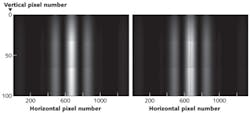FREE-SPACE OPTICAL COMMUNICATION: N-slit interferometer extends secure free-space communications to 527 m
Researchers at Interferometric Optics (Rochester, NY), the US Army Aviation and Missile Command (Redstone Arsenal, AL), Science Applications International Corporation (SAIC), and the US Army Space and Missile Defense Command (both in Huntsville, AL) have extended the range of a secure, terrestrial free-space optical-communications system using an N-slit interferometer design from mere centimeters when first demonstrated to a practical 527 m.1 Furthermore, atmospheric turbulence could be detected over the 527 m propagation distance; the insertion of fine fibers into the optical path was detectable in the laboratory at distances of around 7 m.
The interferometric setup
Empirical interest in N-slit (where N is the number of slits) arrays was first expressed by photonics giants Isaac Newton and Albert Michelson. Because physicist Richard Feynman performed double-slit thought experiments on electrons using Paul Dirac's quantum notation, generalized theoretical equations to describe N-slit interference with a narrow-linewidth laser source were developed in the late 1980s.
Using this interferometric theory, the research team built a simple N-slit interferometer using a 570 μm grating (570-μm-wide slits separated by 570-μm-wide islands) for 7.235 m transmission experiments in the lab, and a 1000 μm grating for 527.33 m transmission experiments through clear, summer night air at 24°C with 66% humidity. Theoretically predicted interferometric configurations denoted by the characters a, b, c, and d (corresponding to illuminating N = 2, 3, 4, and 5 slits of the grating, respectively) were created at the interferometer entrance using an expanded single-transverse-mode 632.8 nm helium-neon laser beam.
In the proof-of-concept experiment at the maximum transmission distance, the patterns produced by the 1000 μm grating were easily detected at the interferometric plane by a calibrated screen and recorded through digital photography. Each of the diffraction patterns was clearly discernable for the characters a through d at an interferometric distance of 527.33 nm as measured by a calibrated laser rangefinder. Predicted and recorded interferograms, in terms of the overall divergence of the interferometric patterns and the position of the spatial features of the interferograms, agree to within 1% to 2%. In addition, digital movie recordings of the interferograms show slight intensity disturbances consistent with atmospheric turbulence and thought to be due to a mild breeze present during experimentation.
A minor intrusion
Experiments using the 570 μm grating and a shorter interferometric distance of 7.235 m were performed using a 1340 pixel CCD array placed at the interferometric plane. The researchers also tested the system security by inserting two fine fibers—a 50-μm-diameter human hair and a 25-to-30-μm-diameter spiderweb fiber—one at a time, close to the detection plane. The minor intrusion in the free-space optical path was clearly visible in the resultant pattern at the detection plane, demonstrating the secure nature of the interferometric terrestrial technique (see figure). More obvious intrusions by conventional thin beamsplitters led to a catastrophic collapse of the signal.
"The N-slit laser interferometer was initially developed to characterize the fidelity of transmission gratings, the optical homogeneity of imaging surfaces, and as a coherent-digital microscopic tool," says researcher Frank Duarte from Interferometric Optics. "The next phase of development for the laboratory version of this instrument is to build an automated infrared version for kilometer-range distances for either secure free-space optical communications or the detection of clear-air turbulence, which is of significant interest for aviation safety."
REFERENCE
1. F.J. Duarte et al., J. Opt., 13, 035710, 1–5 (Feb. 3, 2011).

Gail Overton | Senior Editor (2004-2020)
Gail has more than 30 years of engineering, marketing, product management, and editorial experience in the photonics and optical communications industry. Before joining the staff at Laser Focus World in 2004, she held many product management and product marketing roles in the fiber-optics industry, most notably at Hughes (El Segundo, CA), GTE Labs (Waltham, MA), Corning (Corning, NY), Photon Kinetics (Beaverton, OR), and Newport Corporation (Irvine, CA). During her marketing career, Gail published articles in WDM Solutions and Sensors magazine and traveled internationally to conduct product and sales training. Gail received her BS degree in physics, with an emphasis in optics, from San Diego State University in San Diego, CA in May 1986.
